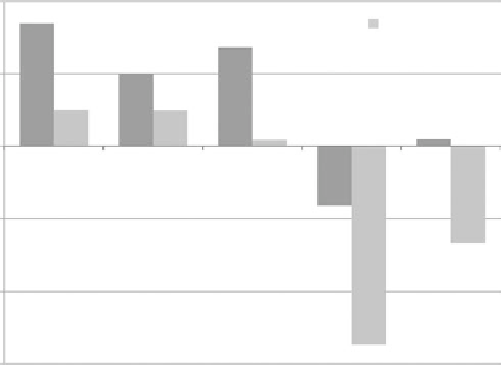Environmental Engineering Reference
In-Depth Information
1000
847
with CO
2
capture
and sequestration
681
499
500
247
245
Biomass
direct-fire
Biomass
IGCC
43
0
Coal
NGCC
Coal/biomass
co-fire
49
-500
-410
-667
-1000
-1368
-1500
FIGure 11.30
Life-cycle GHG emissions of five electricity sources with and without CO
2
-seq. (From Spath,
P.L. and Mann, M.K.,
Biomass Power and Conventional Fossil Systems with and without CO
2
Sequestration—
Comparing the Energy Balance, Greenhouse Gas Emissions and Economics
. NREL/TP-510-32575, National
Renewable Energy Laboratory, Golden, CO, 2004.)
11.3.3.4 carbon sequestration
Spath and Mann (2004) assessed the life-cycle GHG emissions of five electricity generation tech-
nologies, with and without CO
2
-seq: coal, natural gas combined-cycle, biomass co-fire, biomass
direct-fire, and biomass gasification combined-cycle. CO
2
, CH
4
, and N
2
O all contributed to the
GWP of each system, summed in terms of CO
2
e. Although the nitrogen content of coal is high
(72%), most was assumed to become NO
x
, which can contribute to acid rain and photochemical
smog but is not a GHG, rather than N
2
O. The co- and direct-fire systems used waste wood, as
described in Section 11.3.3.2. Each of the biomass electricity systems considered thus far produced
lower life-cycle GHG emissions than the comparative fossil fuel baseline systems. Figure 11.30
shows the life-cycle GHG emissions of the five fuel pathways assessed in Spath and Mann (2004).
CO
2
-seq reduced GHG emissions in every system by at least 50% and by up to 262% when compar-
ing across systems to the coal baseline (no CO
2
-seq).
11.4
land-use ImPacts
11.4.1 i
introduction
In 2007, biofuels were estimated to use 1.87% of global arable land, or 26.6 million ha (Ravindranath
et al. 2008). In the United States, 3.7% of arable land, or 10 million ha, is devoted to corn produc-
tion for ethanol (Goettemoeller and Goettemoeller 2007). Crop yield per land area, market demand,
policy, and natural resource constraints are some of the determining factors of land use for biomass
feedstock crops. In this section, we will discuss production potentials, land requirements for mod-
eled biomass systems, and GHG impacts based on modeling results.
Different biofuel feedstock crops are grown around the world based on geographic suitability. Yield
is an important part of determining total scalability. Some crops yield more biofuel per hectare, and
the same type of crop can produce different yields regionally depending on many factors, including
rainfall, soil characteristics, plant genetics, and nutrient availability. The liquid fuel yields of several
biofuel feedstocks, in gallons per acre, are presented in Figure 11.31. The figure gives an indication of
the land-use benefits that can be achieved with future biofuel feedstocks (i.e., algae and switchgrass).
In Europe, Giant Miscanthus grass has been a focal point of biofuel research, whereas switchgrass
has received more attention in the United States. A recent study suggests that Giant Miscanthus can

